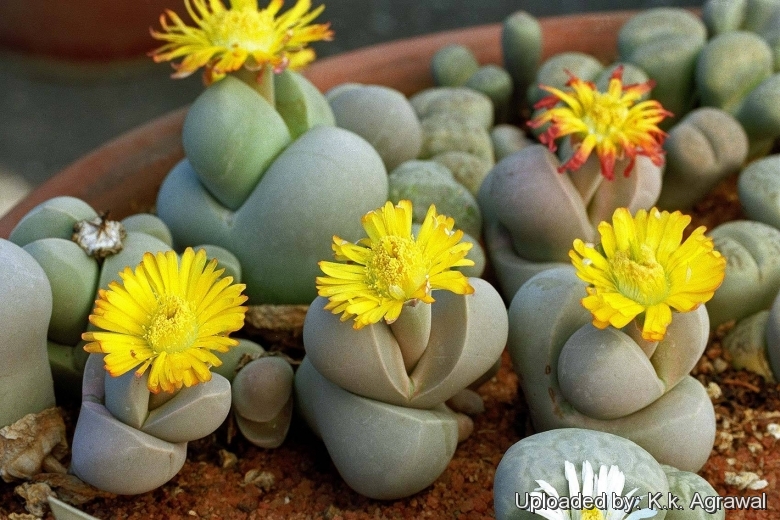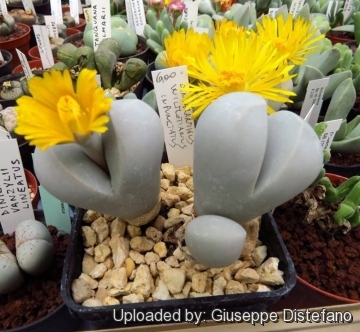




Your support is critical to our success.
Z. Sukkulentenk. ii. 184 (1926). nomen; Dinter in Fedde, Repert. Beih.liii. 106 (1928), in obs.
Family: AIZOACEAE
Accepted Scientific Name: Dinteranthus inexpectatus Dinter ex H.Jacobsen
Sukkulenten [H.Jacobsen] 123 (1933); vide Ingram in Baileya, xvi. 142 (1969). H.Jacobsen

Origin and Habitat: Warmbad, Namibia.
Habitat: It grows on quartz hills under quartz stones, rain in Autumn.
Synonyms:
- Dinteranthus inexpectatus Dinter ex H.Jacobsen
- Dinteranthus wilmotianus var. impunctatus N.Sauer
- Mesembryanthemum inexpectatum Dinter ex Schwantes
Description: Dinteranthus inexpectatusSN|14622]]SN|14624]] is a spheroid mesembs mostly forming a single leaf-pair only or rarely forming small groups.
Leaves: Rounded, egg-like, 2,5-4,5 cm high amd up to 5 cm in diameter, smooth, hairless, uniformly milky-white or grey, sometimes tinged with pink, undotted, broadest in their middle, higher than their widest extension. Leaves semi-ovate, united for more than half their length, gaping sometimes a little and which close up to form a sphere in the dry period. Keels, 1 or 2, inconspicuous most pronounced at the fissure, on the back towards the apex, keel epidermis with dome-shaped cells, their tops often knobby, in the centre a thicker cuticular knob.
Flowers: 1,5-4,5 cm broad, deep yellow. Sepals 8. Petals all golden yellow often with a reddish tinge. Stigmas 6-8.
Fruits. Fr valve wings only moderately broader than the expanding keels, not touching each other in the open capsule at their basal ends, (7-)8 locules.
Remarks: The taxon is easily recognized and well separated from Dinteranthus wilmotianusSN|14624]]SN|14622]].
Notes: The strange appearance of Dinteranthus have made them very popular in succulent collections. They are similar in habit to Lithops but grows above ground (only Dintheranthus vanzily is partly subterranean like Lithops with the top of each leaf tip exposed above soil). They are also called mimicry plants as they show a striking similarity to their background rocks and are difficult to detect when not in flower. The Dinteranthus have a pebbly look and are commonly known as pebble plants or living stones; each species is associated with one particular type of rock formation and occurs nowhere else. This camouflage also reduces the need for chemical defences against herbivores.
Bibliography: Major references and further lectures
1) Heidrun E. K. Hartmann “Aizoaceae F – Z” Springer, 2002
2) James Cullen, Sabina G. Knees, H. Suzanne Cubey “The European Garden Flora Flowering Plants: A Manual for the Identification of Plants Cultivated in Europe, Both Out-of-Doors and Under Glass - Casuarinaceae to Aristolochiaceae” Cambridge University Press, 11/ago/2011
3) Hermann Jacobsen, Vera Higgins “Succulent Plants:Description, Cultivation and Uses of Succulent Plants, Other Than Cacti” Williams and Norgate, Limited, 1935
4) Jacobsen. “Handbook of succulent plants” 1328 (1960)
5) Edgar Lamb “The illustrated reference on cacti and other succulents” Blandford Press, 1978
6) Japan Succulent Society. “Colour encyclopedia of succulents” (1981)
7) John Robert Brown “Unusual plants: 110 spectacular photographs of succulents” Abbey Garden Press, 1954

Mesembryanthemum inexpectatum (Dinteranthus inexpectatus) Photo by: Giuseppe Distefano
The gallery now contains thousands of pictures, however it is possible to do even more. We are, of course, seeking photos of species not yet shown in the gallery but not only that, we are also looking for better pictures than those already present. Read More...
Cultivation and Propagation: Dinteranthus are summer growing species with dry rest period over winter but they do not shows an apparent dormant season like Lithops. Paying attention to the particular growing requirement of Dinteranthus is especially important. If you provide the Dinteranthus with the right conditions, they will reward you with their unique shape, size, colour and a proliferation of blooms in autumn. However, Dinteranthus are tricky plants that are very particular about their growing conditions and require the right maintenance in order to keep happy. But don't be afraid even the best growers have plants that mysteriously dry up, or leave during the night. While Dinteranthus are picky about their care, if you are patient and remember the basics, your efforts will be rewarded. Being small plants, a representative collection can be grown on a patio table, a sunny windowsill or a shelf in the greenhouse.
Growing rate: Slow growing for a mesemb.
Soil: Easy to grow they need a very open mineral, fast draining mix with little compost and a high degree of grit, coarse sand, small lava gravel or pebbles. They can grow outdoor in sunny, dry, rock crevices (protection against winter wet is required) They can also be cultivated in alpine house, in poor, drained soil.
Repotting: Keep them in small pots as solitary clumps or as colonies in large, shallow terracotta seed pans. Dinteranthus may stay in the same pot for many years. Plants grown in larger containers have frequently relatively poor flowers. Flowers might improve when the plants are given their own, small individual pots.
Exposition: Give them the maximum amount of light you are able to give them, but care should be taken about exposing them to the full blast of the sun rays in summer (The only exception to this is seedlings in their first year that enjoy a shades place). Such tiny plants can easily get scorched or broiled and their appearance spoiled (this may not matter in the wild, where the Dinteranthus have probably shrunk into the ground and becomes covered with sands).
Basic watering routine: Gives some water all year, more in Spring and again in autumn. Keep rather dry during coldest winter month and start watering regularly after the old leaves completely dry. (Usually late March or Early April) Water freely during the growing season, soak the compost fully but allow it to dry out between waterings. Nearly all problems occur as a result of overwatering and poor ventilation especially when weather conditions are dull and cool or very humid. If too much water is supplied the plants will grow out of character, bloat, split and rot. When in doubt DON'T WATER. Where the resting season is in the winter and central heating gives very dry air in the home, give a light top spray once a week to simulate the desert dew and prevent excessive dehydration. After flowering in the summer and extending through winter season the plant doesn’t need watering, but they will still be growing, the new bodies will be increasing in size extracting water from the outer succulent leaves, allowing them to shrivel away. In fact the plant in this time extracts water and nutrient stored in the outer succulent leaves, allowing them to dehydrate relocating the water to the rest of the plant and to the new leaves that form during this period until the old leaves are reduced to nothing more than "thin papery shells".
Fertilization: Feed them once during the growing season with a fertilizer specifically formulated for cactus and succulents (high potash fertilizer with a dilute low nitrogen), including all micro nutrients and trace elements diluted to ½ the strength recommended on the label. They thrive in poor soils and need a limited supplies of fertilizer to avoid the plants developing excess vegetation, which is easily attacked by fungal diseases. Some growers fertilize frequently, some hardly ever. However, for the highly succulent mesembs, (Lithops, Conophytums, etc.) fertilization is not really necessary.
Hardiness: Overwinter them preferably not below 5° C (But will take a light frost and are hardy down to -7° C for short periods if they are in dry soil). USDA zones 9A – 11.
Uses: Container, rock garden.
Pests & diseases: Dinteranthus may be attractive to a variety of insects, but plants in good condition should be nearly pest-free, particularly if they are grown in a mineral potting-mix, with good exposure and ventilation. Nonetheless, there are several pests to watch for:
- Red spiders: they may be effectively rubbed up by misting the vulnerable plants every day
- Mealy bugs: occasianlly they develop aerial into the new leaves and flowers with disfiguring results, but the worst types develop underground on the roots and are invisible except by their effects.
- Sciara Flies: they are one of the major problems for seedlings. It is a good practice to mulch your seedlings with a layer of grit, which will strongly discourage the flies.
- Scales, thrips and aphids: they are rarely a problem.
It is wise to treat your whole collection with a systemic insecticide twice a year in spring and autumn.
- Rot: it is only a minor problem with mesembs if the plants are watered and “aired” correctly. If they are not, fungicides won't help all that much.
Propagation: From seed (very small) or by dividing older clumps. The small seeds can be sown in pots of fine, well-drained sand, any time during the spring and summer months when temperatures are warm. Cover the seeds with a very fine layer of grit and water from below with a fungicide to prevent damping off. For the first 3-4 days cover the pots with a sheet of glass/clear perspex to keep the humidity levels high. Remove the glass and replace it with light shadecloth and mist once or twice a day for the next two weeks after which most seeds should have germinated. From then on mistings can be reduced to every second and then every third day as the little plants grow. Take the cuttings from a grown-up mother plant. Each cutting must contain one or more heads along with a fraction of root and permit them to dry out a couple of days, lay the cuttings on the soil and insert the stem end partially into the soil. Try to keep the cutting somewhat upright so that the roots are able to grow downward. It is relatively difficult to root Dinteranthus from cuttings and generally pointless as well, so quick are they from seed.
| Your Actions | |
|---|---|
| Back to Mesembryanthemum index | |
| Back to Aizoaceae index | |
 |
Back to Succulents Encyclopedia index |
Privacy stantement - Terms and conditions - How to cite - About us - Feedback - Donate



